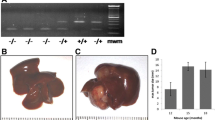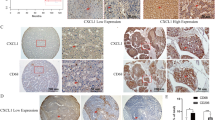Abstract
Purpose
In many cancer patients, the malignancy causes reduced hepatic drug clearance leading to potentially serious complications from the use of anticancer drugs. The mechanisms underlying this phenomenon are poorly understood. We aimed to identify tumor-associated inflammatory pathways that alter drug response and enhance chemotherapy-associated toxicity.
Methods
We studied inflammatory pathways involved in extra-hepatic tumor mediated repression of CYP3A, a major hepatic drug metabolizing cytochrome P450 subfamily, using a murine Engelbreth-Holm-Swarm sarcoma model. Studies in IL-6 knockout mice determined the source of elevated IL-6 in tumor-bearing animals and monoclonal antibodies against IL-6 were used to intervene in this inflammatory pathway.
Results
Our studies confirm elevated plasma IL-6 levels and reveal activation of Jak/Stat and Mapk signalling pathways and acute phase proteins in livers of tumor-bearing mice. Circulating IL-6 was predominantly produced by the tumor xenograft, rather than being host derived. Anti IL-6 antibody intervention partially reversed tumor-mediated inflammation and Cyp3a gene repression.
Conclusions
IL-6 is an important player in cancer-related repression of CYP3A-mediated drug metabolism and activation of the acute phase response. Targeting IL-6 in cancer patients may prove an effective approach to alleviating cancer-related phenomena, such as adverse drug-related outcomes commonly associated with cancer chemotherapy.




Similar content being viewed by others
Abbreviations
- CRP:
-
C-reactive protein
- CYP3A4:
-
Cytochrome P450 3A4
- EHS:
-
Engelbreth-Holm-Swarm Sarcoma
- ERK:
-
extracellular-signal-regulated kinases
- GAPDH:
-
glyceraldehyde 3-phosphate dehydrogenase
- gp130:
-
glycoprotein 130
- IL-1β:
-
interleukin-1 beta
- IL-6:
-
interleukin-6
- JAK:
-
Janus kinase
- Jnk:
-
c-Jun N-terminal kinases
- MAPK:
-
mitogen-activated protein kinase
- SAP:
-
serum amyloid P
- SAPK:
-
stress-activated protein kinases
- STAT:
-
signal transducers and activators of transcription
- TNF-α:
-
tumor necrosis factor-alpha
References
Kacevska M, Robertson GR, Clarke SJ, Liddle C. Inflammation and CYP3A4-mediated drug metabolism in advanced cancer: impact and implications for chemotherapeutic drug dosing. Expert Opin Drug Metab Toxicol. 2008;4(2):137–49. PubMed PMID: 18248309. Epub 2008/02/06. eng.
Robertson GR, Liddle C, Clarke SJ. Inflammation and altered drug clearance in cancer: transcriptional repression of a human CYP3A4 transgene in tumor-bearing mice. Clin Pharmacol Ther. 2008;83(6):894–7. PubMed PMID: 18388870. Epub 2008/04/05. eng.
Kivisto KT, Kroemer HK, Eichelbaum M. The role of human cytochrome P450 enzymes in the metabolism of anticancer agents: implications for drug interactions. Br J Clin Pharmacol. 1995;40(6):523–30. PubMed PMID: 8703657. Pubmed Central PMCID: 1365206. Epub 1995/12/01. eng.
Rivory LP, Slaviero KA, Clarke SJ. Hepatic cytochrome P450 3A drug metabolism is reduced in cancer patients who have an acute-phase response. Br J Cancer. 2002;87(3):277–80.
Slaviero KA, Clarke SJ, Rivory LP. Inflammatory response: an unrecognised source of variability in the pharmacokinetics and pharmacodynamics of cancer chemotherapy. Lancet Oncol. 2003;4(4):224–32.
Aggarwal BB, Shishodia S, Sandur SK, Pandey MK, Sethi G. Inflammation and cancer: how hot is the link? Biochem Pharmacol. 2006;72(11):1605–21. PubMed PMID: 16889756. Epub 2006/08/08. eng.
Seruga B, Zhang H, Bernstein LJ, Tannock IF. Cytokines and their relationship to the symptoms and outcome of cancer. Nat Rev Cancer. 2008;8(11):887–99. PubMed PMID: 18846100. Epub 2008/10/11. eng.
Proctor MJ, Morrison DS, Talwar D, Balmer SM, O’Reilly DS, Foulis AK, et al. An inflammation-based prognostic score (mGPS) predicts cancer survival independent of tumour site: a Glasgow Inflammation Outcome Study. Br J Cancer. 2011;104(4):726–34. PubMed PMID: 21266974. Pubmed Central PMCID: 3049591. Epub 2011/01/27. eng.
Elsberger B, Lankston L, McMillan DC, Underwood MA, Edwards J. Presence of tumoural C-reactive protein correlates with progressive prostate cancer. Prostate Cancer Prostatic Dis. 2011;14(2):122–8. PubMed PMID: 21358753. Epub 2011/03/02. eng.
Ravishankaran P, Karunanithi R. Clinical significance of preoperative serum interleukin-6 and C-reactive protein level in breast cancer patients. World J Surg Oncol. 2011;9(1):18. PubMed PMID: 21294915. Pubmed Central PMCID: 3045973. Epub 2011/02/08. eng.
Saito K, Kihara K. Role of C-reactive protein as a biomarker for renal cell carcinoma. Expert Rev Anticancer Ther. 2010;10(12):1979–89. PubMed PMID: 21110763. Epub 2010/11/30. eng.
Trikha M, Corringham R, Klein B, Rossi JF. Targeted anti-interleukin-6 monoclonal antibody therapy for cancer: a review of the rationale and clinical evidence. Clin Cancer Res. 2003;9(13):4653–65. PubMed PMID: 14581334. Epub 2003/10/29. eng.
Hong DS, Angelo LS, Kurzrock R. Interleukin-6 and its receptor in cancer: implications for translational therapeutics. Cancer. 2007;110(9):1911–28. PubMed PMID: 17849470. Epub 2007/09/13. eng.
Evans WJ, Morley JE, Argiles J, Bales C, Baracos V, Guttridge D, et al. Cachexia: a new definition. Clin Nutr. 2008;27(6):793–9. PubMed PMID: 18718696. Epub 2008/08/23. eng.
Castell JV, Gomez-Lechon MJ, David M, Andus T, Geiger T, Trullenque R, et al. Interleukin-6 is the major regulator of acute phase protein synthesis in adult human hepatocytes. FEBS Lett. 1989;242(2):237–9. PubMed PMID: 2464504. Epub 1989/01/02. eng.
Guillen MI, Donato MT, Jover R, Castell JV, Fabra R, Trullenque R, et al. Oncostatin M down-regulates basal and induced cytochromes P450 in human hepatocytes. J Pharmacol Exp Ther. 1998;285(1):127–34. PubMed PMID: 9536002. Epub 1998/05/16. eng.
Siewert E, Bort R, Kluge R, Heinrich PC, Castell J, Jover R. Hepatic cytochrome P450 down-regulation during aseptic inflammation in the mouse is interleukin 6 dependent. Hepatology. 2000;32(1):49–55. PubMed PMID: 10869288. Epub 2000/06/28. eng.
Bode JG, Ludwig S, Freitas CA, Schaper F, Ruhl M, Melmed S, et al. The MKK6/p38 mitogen-activated protein kinase pathway is capable of inducing SOCS3 gene expression and inhibits IL-6-induced transcription. Biol Chem. 2001;382(10):1447–53. PubMed PMID: 11727828. Epub 2001/12/01. eng.
Heinrich PC, Behrmann I, Haan S, Hermanns HM, Muller-Newen G, Schaper F. Principles of interleukin (IL)-6-type cytokine signalling and its regulation. Biochem J. 2003;374(Pt 1):1–20. PubMed PMID: 12773095. Epub 2003/05/30. eng.
Lang R, Pauleau AL, Parganas E, Takahashi Y, Mages J, Ihle JN, et al. SOCS3 regulates the plasticity of gp130 signaling. Nat Immunol. 2003;4(6):546–50. PubMed PMID: 12754506. Epub 2003/05/20. eng.
Croker BA, Krebs DL, Zhang JG, Wormald S, Willson TA, Stanley EG, et al. SOCS3 negatively regulates IL-6 signaling in vivo. Nat Immunol. 2003;4(6):540–5. PubMed PMID: 12754505. Epub 2003/05/20. eng.
Sharma R, Kacevska M, London R, Clarke SJ, Liddle C, Robertson G. Downregulation of drug transport and metabolism in mice bearing extra-hepatic malignancies. Br J Cancer. 2008;98(1):91–7. PubMed PMID: 18059400. Epub 2007/12/07. eng.
Charles KA, Rivory LP, Brown SL, Liddle C, Clarke SJ, Robertson GR. Transcriptional repression of hepatic cytochrome P450 3A4 gene in the presence of cancer. Clin Cancer Res. 2006;12(24):7492–7. PubMed PMID: 17189422. eng.
Kacevska M, Downes MR, Sharma R, Evans RM, Clarke SJ, Liddle C, et al. Extrahepatic cancer suppresses nuclear receptor-regulated drug metabolism. Clin Cancer Res. 2011;17(10):3170–80. PubMed PMID: 21498392. Pubmed Central PMCID: 3096719. Epub 2011/04/19. eng.
Watanabe M, Tateishi T, Asoh M, Nakura H, Tanaka M, Kumai T, et al. Effects of glucocorticoids on pharmacokinetics and pharmacodynamics of midazolam in rats. Life Sci. 1998;63(19):1685–92. PubMed PMID: 9806224. Epub 1998/11/07. eng.
Perloff MD, von Moltke LL, Court MH, Kotegawa T, Shader RI, Greenblatt DJ. Midazolam and triazolam biotransformation in mouse and human liver microsomes: relative contribution of CYP3A and CYP2C isoforms. J Pharmacol Exp Ther. 2000;292(2):618–28. PubMed PMID: 10640299.
Rawlings JS, Rosler KM, Harrison DA. The JAK/STAT signaling pathway. J Cell Sci. 2004;117(Pt 8):1281–3. PubMed PMID: 15020666. Epub 2004/03/17. eng.
Seger R, Krebs EG. The MAPK signaling cascade. FASEB J. 1995;9(9):726–35. PubMed PMID: 7601337. Epub 1995/06/01. eng.
Endo TA, Masuhara M, Yokouchi M, Suzuki R, Sakamoto H, Mitsui K, et al. A new protein containing an SH2 domain that inhibits JAK kinases. Nature. 1997;387(6636):921–4. PubMed PMID: 9202126. Epub 1997/06/26. eng.
Krebs DL, Hilton DJ. SOCS proteins: negative regulators of cytokine signaling. Stem Cells. 2001;19(5):378–87. PubMed PMID: 11553846. Epub 2001/09/13. eng.
Szalai AJ, van Ginkel FW, Dalrymple SA, Murray R, McGhee JR, Volanakis JE. Testosterone and IL-6 requirements for human C-reactive protein gene expression in transgenic mice. J Immunol. 1998;160(11):5294–9. PubMed PMID: 9605127. Epub 1998/05/30. eng.
Zimmers TA, McKillop IH, Pierce RH, Yoo JY, Koniaris LG. Massive liver growth in mice induced by systemic interleukin 6 administration. Hepatology. 2003;38(2):326–34. PubMed PMID: 12883476. Epub 2003/07/29. eng.
Moshage H. Cytokines and the hepatic acute phase response. J Pathol. 1997;181(3):257–66.
Bilzer M, Roggel F, Gerbes AL. Role of Kupffer cells in host defense and liver disease. Liver Int Off J Int Assoc Study Liver. 2006;26(10):1175–86. PubMed PMID: 17105582.
Morgan ET. Regulation of cytochrome p450 by inflammatory mediators: why and how? Drug Metab Dispos. 2001;29(3):207–12. PubMed PMID: 11181485. eng.
Jover R, Bort R, Gomez-Lechon MJ, Castell JV. Down-regulation of human CYP3A4 by the inflammatory signal interleukin-6: molecular mechanism and transcription factors involved. FASEB J. 2002;16(13):1799–801. PubMed PMID: 12354697. eng.
Heinrich PC, Behrmann I, Muller-Newen G, Schaper F, Graeve L. Interleukin-6-type cytokine signalling through the gp130/Jak/STAT pathway. Biochem J. 1998;334(Pt 2):297–314. PubMed PMID: 9716487. Epub 1998/08/26. eng.
Plante M, Rubin SC, Wong GY, Federici MG, Finstad CL, Gastl GA. Interleukin-6 level in serum and ascites as a prognostic factor in patients with epithelial ovarian cancer. Cancer. 1994;73(7):1882–8. PubMed PMID: 8137215. Epub 1994/04/01. eng.
Seymour JF, Talpaz M, Cabanillas F, Wetzler M, Kurzrock R. Serum interleukin-6 levels correlate with prognosis in diffuse large-cell lymphoma. J Clin Oncol. 1995;13(3):575–82. PubMed PMID: 7884418. Epub 1995/03/01. eng.
Twillie DA, Eisenberger MA, Carducci MA, Hseih WS, Kim WY, Simons JW. Interleukin-6: a candidate mediator of human prostate cancer morbidity. Urology. 1995;45(3):542–9. PubMed PMID: 7879350. Epub 1995/03/01. eng.
Bataille R, Barlogie B, Lu ZY, Rossi JF, Lavabre-Bertrand T, Beck T, et al. Biologic effects of anti-interleukin-6 murine monoclonal antibody in advanced multiple myeloma. Blood. 1995;86(2):685–91. PubMed PMID: 7605999. Epub 1995/07/15. eng.
Lu ZY, Brailly H, Wijdenes J, Bataille R, Rossi JF, Klein B. Measurement of whole body interleukin-6 (IL-6) production: prediction of the efficacy of anti-IL-6 treatments. Blood. 1995;86(8):3123–31. PubMed PMID: 7579407. Epub 1995/10/15. eng.
Nishimoto N, Kishimoto T. Humanized antihuman IL-6 receptor antibody, tocilizumab. Handb Exp Pharmacol. 2008 181:151–60. PubMed PMID: 18071945. Epub 2007/12/12. eng.
Ahmed B, Tschen JA, Cohen PR, Zaki MH, Rady PL, Tyring SK, et al. Cutaneous castleman’s disease responds to anti interleukin-6 treatment. Mol Cancer Ther. 2007;6(9):2386–90. PubMed PMID: 17766835. Epub 2007/09/04. eng.
Montero-Julian FA, Gautherot E, Wijdenes J, Klein B, Brailly H. Pharmacokinetics of interleukin-6 during therapy with anti-interleukin-6 monoclonal antibodies: enhanced clearance of interleukin-6 by a combination of three anti-interleukin-6 antibodies. J Interferon Res. 1994;14(5):301–2. PubMed PMID: 7861038. Epub 1994/10/01. eng.
Montero-Julian FA, Klein B, Gautherot E, Brailly H. Pharmacokinetic study of anti-interleukin-6 (IL-6) therapy with monoclonal antibodies: enhancement of IL-6 clearance by cocktails of anti-IL-6 antibodies. Blood. 1995;85(4):917–24. PubMed PMID: 7849313. Epub 1995/02/15. eng.
Rose-John S, Waetzig GH, Scheller J, Grotzinger J, Seegert D. The IL-6/sIL-6R complex as a novel target for therapeutic approaches. Expert Opin Ther Targets. 2007;11(5):613–24. PubMed PMID: 17465721. Epub 2007/05/01. eng.
Acknowledgments and Disclosures
This work was supported by National Health and Medical Research Council of Australia Project Grants 352419 (GRR, SJC, CL) and 402493 (CL). The authors have no competing interests to disclose.
Author information
Authors and Affiliations
Corresponding author
Rights and permissions
About this article
Cite this article
Kacevska, M., Mahns, A., Sharma, R. et al. Extra-Hepatic Cancer Represses Hepatic Drug Metabolism Via Interleukin (IL)-6 Signalling. Pharm Res 30, 2270–2278 (2013). https://doi.org/10.1007/s11095-013-1042-3
Received:
Accepted:
Published:
Issue Date:
DOI: https://doi.org/10.1007/s11095-013-1042-3




